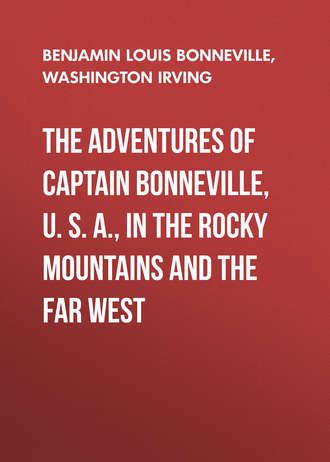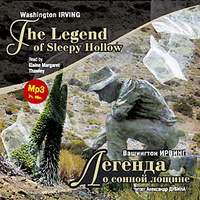 полная версия
полная версияThe Adventures of Captain Bonneville, U. S. A., in the Rocky Mountains and the Far West
At length, after six weeks’ absence, the hunters made their appearance, and were received with joy proportioned to the anxiety that had been felt on their account. They had hunted with success on the prairie, but, while busy drying buffalo meat, were joined by a few panic-stricken Flatheads, who informed them that a powerful band of Blackfeet was at hand. The hunters immediately abandoned the dangerous hunting ground, and accompanied the Flatheads to their village. Here they found Mr. Cerre, and the detachment of hunters sent with him to accompany the hunting party of the Nez Perces.
After remaining some time at the village, until they supposed the Blackfeet to have left the neighborhood, they set off with some of Mr. Cerre’s men for the cantonment at Salmon River, where they arrived without accident. They informed Captain Bonneville, however, that not far from his quarters they had found a wallet of fresh meat and a cord, which they supposed had been left by some prowling Blackfeet. A few days afterward Mr. Cerre, with the remainder of his men, likewise arrived at the cantonment.
Mr. Walker, one of his subleaders, who had gone with a band of twenty hunters to range the country just beyond the Horse Prairie, had likewise his share of adventures with the all-pervading Blackfeet. At one of his encampments the guard stationed to keep watch round the camp grew weary of their duty, and feeling a little too secure, and too much at home on these prairies, retired to a small grove of willows to amuse themselves with a social game of cards called “old sledge,” which is as popular among these trampers of the prairies as whist or ecarte among the polite circles of the cities. From the midst of their sport they were suddenly roused by a discharge of firearms and a shrill war-whoop. Starting on their feet, and snatching up their rifles, they beheld in dismay their horses and mules already in possession of the enemy, who had stolen upon the camp unperceived, while they were spell-bound by the magic of old sledge. The Indians sprang upon the animals barebacked, and endeavored to urge them off under a galling fire that did some execution. The mules, however, confounded by the hurly-burly and disliking their new riders kicked up their heels and dismounted half of them, in spite of their horsemanship. This threw the rest into confusion; they endeavored to protect their unhorsed comrades from the furious assaults of the whites; but, after a scene of “confusion worse confounded,” horses and mules were abandoned, and the Indians betook themselves to the bushes. Here they quickly scratched holes in the earth about two feet deep, in which they prostrated themselves, and while thus screened from the shots of the white men, were enabled to make such use of their bows and arrows and fusees, as to repulse their assailants and to effect their retreat. This adventure threw a temporary stigma upon the game of “old sledge.”
In the course of the autumn, four Iroquois hunters, driven by the snow from their hunting grounds, made their appearance at the cantonment. They were kindly welcomed, and during their sojourn made themselves useful in a variety of ways, being excellent trappers and first-rate woodsmen. They were of the remnants of a party of Iroquois hunters that came from Canada into these mountain regions many years previously, in the employ of the Hudson’s Bay Company. They were led by a brave chieftain, named Pierre, who fell by the hands of the Blackfeet, and gave his name to the fated valley of Pierre’s Hole. This branch of the Iroquois tribe has ever since remained among these mountains, at mortal enmity with the Blackfeet, and have lost many of their prime hunters in their feuds with that ferocious race. Some of them fell in with General Ashley, in the course of one of his gallant excursions into the wilderness, and have continued ever since in the employ of the company.
Among the motley Visitors to the winter quarters of Captain Bonneville was a party of Pends Oreilles (or Hanging-ears) and their chief. These Indians have a strong resemblance, in character and customs, to the Nez Perces. They amount to about three hundred lodges, are well armed, and possess great numbers of horses. During the spring, summer, and autumn, they hunt the buffalo about the head-waters of the Missouri, Henry’s Fork of the Snake River, and the northern branches of Salmon River. Their winter quarters are upon the Racine Amere, where they subsist upon roots and dried buffalo meat. Upon this river the Hudson’s Bay Company have established a trading post, where the Pends Oreilles and the Flatheads bring their peltries to exchange for arms, clothing and trinkets.
This tribe, like the Nez Perces, evince strong and peculiar feelings of natural piety. Their religion is not a mere superstitious fear, like that of most savages; they evince abstract notions of morality; a deep reverence for an overruling spirit, and a respect for the rights of their fellow men. In one respect their religion partakes of the pacific doctrines of the Quakers. They hold that the Great Spirit is displeased with all nations who wantonly engage in war; they abstain, therefore, from all aggressive hostilities. But though thus unoffending in their policy, they are called upon continually to wage defensive warfare; especially with the Blackfeet; with whom, in the course of their hunting expeditions, they come in frequent collision and have desperate battles. Their conduct as warriors is without fear or reproach, and they can never be driven to abandon their hunting grounds.
Like most savages they are firm believers in dreams, and in the power and efficacy of charms and amulets, or medicines as they term them. Some of their braves, also, who have had numerous hairbreadth ‘scapes, like the old Nez Perce chief in the battle of Pierre’s Hole, are believed to wear a charmed life, and to be bullet-proof. Of these gifted beings marvelous anecdotes are related, which are most potently believed by their fellow savages, and sometimes almost credited by the white hunters.
11
Rival trapping parties – Manoeuvring – A desperate game – Vanderburgh and the Blackfeet – Deserted camp fire – A dark defile – An Indian ambush – A fierce melee – Fatal consequences – Fitzpatrick and Bridger – Trappers precautions – Meeting with the Blackfeet – More fighting – Anecdote of a young – Mexican and an Indian girl.
WHILE Captain Bonneville and his men are sojourning among the Nez Perces, on Salmon River, we will inquire after the fortunes of those doughty rivals of the Rocky Mountains and American Fur Companies, who started off for the trapping grounds to the north-northwest.
Fitzpatrick and Bridger, of the former company, as we have already shown, having received their supplies, had taken the lead, and hoped to have the first sweep of the hunting grounds. Vanderburgh and Dripps, however, the two resident partners of the opposite company, by extraordinary exertions were enabled soon to put themselves upon their traces, and pressed forward with such speed as to overtake them just as they had reached the heart of the beaver country. In fact, being ignorant of the best trapping grounds, it was their object to follow on, and profit by the superior knowledge of the other party.
Nothing could equal the chagrin of Fitzpatrick and Bridger at being dogged by their inexperienced rivals, especially after their offer to divide the country with them. They tried in every way to blind and baffle them; to steal a march upon them, or lead them on a wrong scent; but all in vain. Vanderburgh made up by activity and intelligence for his ignorance of the country; was always wary, always on the alert; discovered every movement of his rivals, however secret and was not to be eluded or misled.
Fitzpatrick and his colleague now lost all patience; since the others persisted in following them, they determined to give them an unprofitable chase, and to sacrifice the hunting season rather than share the products with their rivals. They accordingly took up their line of march down the course of the Missouri, keeping the main Blackfoot trail, and tramping doggedly forward, without stopping to set a single trap. The others beat the hoof after them for some time, but by degrees began to perceive that they were on a wild-goose chase, and getting into a country perfectly barren to the trapper. They now came to a halt, and be-thought themselves how to make up for lost time, and improve the remainder of the season. It was thought best to divide their forces and try different trapping grounds. While Dripps went in one direction, Vanderburgh, with about fifty men, proceeded in another. The latter, in his headlong march had got into the very heart of the Blackfoot country, yet seems to have been unconscious of his danger. As his scouts were out one day, they came upon the traces of a recent band of savages. There were the deserted fires still smoking, surrounded by the carcasses of buffaloes just killed. It was evident a party of Blackfeet had been frightened from their hunting camp, and had retreated, probably to seek reinforcements. The scouts hastened back to the camp, and told Vanderburgh what they had seen. He made light of the alarm, and, taking nine men with him, galloped off to reconnoitre for himself. He found the deserted hunting camp just as they had represented it; there lay the carcasses of buffaloes, partly dismembered; there were the smouldering fires, still sending up their wreaths of smoke; everything bore traces of recent and hasty retreat; and gave reason to believe that the savages were still lurking in the neighborhood. With heedless daring, Vanderburgh put himself upon their trail, to trace them to their place of concealment: It led him over prairies, and through skirts of woodland, until it entered a dark and dangerous ravine. Vanderburgh pushed in, without hesitation, followed by his little band. They soon found themselves in a gloomy dell, between steep banks overhung with trees, where the profound silence was only broken by the tramp of their own horses.
Suddenly the horrid war-whoop burst on their ears, mingled with the sharp report of rifles, and a legion of savages sprang from their concealments, yelling, and shaking their buffalo robes to frighten the horses. Vanderburgh’s horse fell, mortally wounded by the first discharge. In his fall he pinned his rider to the ground, who called in vain upon his men to assist in extricating him. One was shot down scalped a few paces distant; most of the others were severely wounded, and sought their safety in flight. The savages approached to dispatch the unfortunate leader, as he lay struggling beneath his horse.. He had still his rifle in his hand and his pistols in his belt. The first savage that advanced received the contents of the rifle in his breast, and fell dead upon the spot; but before Vanderburgh could draw a pistol, a blow from a tomahawk laid him prostrate, and he was dispatched by repeated wounds.
Such was the fate of Major Henry Vanderburgh, one of the best and worthiest leaders of the American Fur Company, who by his manly bearing and dauntless courage is said to have made himself universally popular among the bold-hearted rovers of the wilderness.
Those of the little band who escaped fled in consternation to the camp, and spread direful reports of the force and ferocity of the enemy. The party, being without a head, were in complete confusion and dismay, and made a precipitate retreat, without attempting to recover the remains of their butchered leader. They made no halt until they reached the encampment of the Pends Oreilles, or Hanging-ears, where they offered a reward for the recovery of the body, but without success; it never could be found.
In the meantime Fitzpatrick and Bridger, of the Rocky Mountain Company, fared but little better than their rivals. In their eagerness to mislead them they betrayed themselves into danger, and got into a region infested with the Blackfeet. They soon found that foes were on the watch for them; but they were experienced in Indian warfare, and not to be surprised at night, nor drawn into an ambush in the daytime. As the evening advanced, the horses were all brought in and picketed, and a guard was stationed round the camp. At the earliest streak of day one of the leaders would mount his horse, and gallop off full speed for about half a mile; then look round for Indian trails, to ascertain whether there had been any lurkers round the camp; returning slowly, he would reconnoitre every ravine and thicket where there might be an ambush. This done, he would gallop off in an opposite direction and repeat the same scrutiny. Finding all things safe, the horses would be turned loose to graze, but always under the eye of a guard.
A caution equally vigilant was observed in the march, on approaching any defile or place where an enemy might lie in wait; and scouts were always kept in the advance, or along the ridges and rising grounds on the flanks.
At length, one day, a large band of Blackfeet appeared in the open field, but in the vicinity of rocks and cliffs. They kept at a wary distance, but made friendly signs. The trappers replied in the same way, but likewise kept aloof. A small party of Indians now advanced, bearing the pipe of peace; they were met by an equal number of white men, and they formed a group midway between the two bands, where the pipe was circulated from hand to hand, and smoked with all due ceremony. An instance of natural affection took place at this pacific meeting. Among the free trappers in the Rocky Mountain band was a spirited young Mexican named Loretto, who, in the course of his wanderings, had ransomed a beautiful Blackfoot girl from a band of Crows by whom she had been captured. He made her his wife, after the Indian style, and she had followed his fortunes ever since, with the most devoted affection.
Among the Blackfeet warriors who advanced with the calumet of peace she recognized a brother. Leaving her infant with Loretto she rushed forward and threw herself upon her brother’s neck, who clasped his long-lost sister to his heart with a warmth of affection but little compatible with the reputed stoicism of the savage.
While this scene was taking place, Bridger left the main body of trappers and rode slowly toward the group of smokers, with his rifle resting across the pommel of his saddle. The chief of the Blackfeet stepped forward to meet him. From some unfortunate feeling of distrust Bridger cocked his rifle just as the chief was extending his hand in friendship. The quick ear of the savage caught the click of the lock; in a twinkling he grasped the barrel, forced the muzzle downward, and the contents were discharged into the earth at his feet. His next movement was to wrest the weapon from the hand of Bridger and fell him with it to the earth. He might have found this no easy task had not the unfortunate leader received two arrows in his back during the struggle.
The chief now sprang into the vacant saddle and galloped off to his band. A wild hurry-skurry scene ensued; each party took to the banks, the rocks and trees, to gain favorable positions, and an irregular firing was kept up on either side, without much effect. The Indian girl had been hurried off by her people at the outbreak of the affray. She would have returned, through the dangers of the fight, to her husband and her child, but was prevented by her brother. The young Mexican saw her struggles and her agony, and heard her piercing cries. With a generous impulse he caught up the child in his arms, rushed forward, regardless of Indian shaft or rifle, and placed it in safety upon her bosom. Even the savage heart of the Blackfoot chief was reached by this noble deed. He pronounced Loretto a madman for his temerity, but bade him depart in peace. The young Mexican hesitated; he urged to have his wife restored to him, but her brother interfered, and the countenance of the chief grew dark. The girl, he said, belonged to his tribe-she must remain with her people. Loretto would still have lingered, but his wife implored him to depart, lest his life should be endangered. It was with the greatest reluctance that he returned to his companions.
The approach of night put an end to the skirmishing fire of the adverse parties, and the savages drew off without renewing their hostilities. We cannot but remark that both in this affair and that of Pierre’s Hole the affray commenced by a hostile act on the part of white men at the moment when the Indian warrior was extending the hand of amity. In neither instance, as far as circumstances have been stated to us by different persons, do we see any reason to suspect the savage chiefs of perfidy in their overtures of friendship. They advanced in the confiding way usual among Indians when they bear the pipe of peace, and consider themselves sacred from attack. If we violate the sanctity of this ceremonial, by any hostile movement on our part, it is we who incur the charge of faithlessness; and we doubt not that in both these instances the white men have been considered by the Blackfeet as the aggressors, and have, in consequence, been held up as men not to be trusted.
A word to conclude the romantic incident of Loretto and his Indian bride. A few months subsequent to the event just related, the young Mexican settled his accounts with the Rocky Mountain Company, and obtained his discharge. He then left his comrades and set off to rejoin his wife and child among her people; and we understand that, at the time we are writing these pages, he resides at a trading-house established of late by the American Fur Company in the Blackfoot country, where he acts as an interpreter, and has his Indian girl with him.
12
A winter camp in the wilderness – Medley of trappers, hunters, and Indians – Scarcity of game – New arrangements in the camp – Detachments sent to a distance – Carelessness of the Indians when encamped – Sickness among the Indians – Excellent character of the Nez-Perces – The Captain’s effort as a pacificator – A Nez-Perce’s argument in favor of war – Robberies, by the Black feet – Long suffering of the NezPerces – A hunter’s Elysium among the mountains – More robberies – The Captain preaches up a crusade – The effect upon his hearers.
FOR the greater part of the month of November Captain Bonneville remained in his temporary post on Salmon River. He was now in the full enjoyment of his wishes; leading a hunter’s life in the heart of the wilderness, with all its wild populace around him. Beside his own people, motley in character and costume – creole, Kentuckian, Indian, half-breed, hired trapper, and free trapper – he was surrounded by encampments of Nez Perces and Flatheads, with their droves of horses covering the hills and plains. It was, he declares, a wild and bustling scene. The hunting parties of white men and red men, continually sallying forth and returning; the groups at the various encampments, some cooking, some working, some amusing themselves at different games; the neighing of horses, the braying of asses, the resounding strokes of the axe, the sharp report of the rifle, the whoop, the halloo, and the frequent burst of laughter, all in the midst of a region suddenly roused from perfect silence and loneliness by this transient hunters’ sojourn, realized, he says, the idea of a “populous solitude.”
The kind and genial character of the captain had, evidently, its influence on the opposite races thus fortuitously congregated together. The most perfect harmony prevailed between them. The Indians, he says, were friendly in their dispositions, and honest to the most scrupulous degree in their intercourse with the white men. It is true they were somewhat importunate in their curiosity, and apt to be continually in the way, examining everything with keen and prying eye, and watching every movement of the white men. All this, however, was borne with great good-humor by the captain, and through his example by his men. Indeed, throughout all his transactions he shows himself the friend of the poor Indians, and his conduct toward them is above all praise.
The Nez Perces, the Flatheads, and the Hanging-ears pride themselves upon the number of their horses, of which they possess more in proportion than any other of the mountain tribes within the buffalo range. Many of the Indian warriors and hunters encamped around Captain Bonneville possess from thirty to forty horses each. Their horses are stout, well-built ponies, of great wind, and capable of enduring the severest hardship and fatigue. The swiftest of them, however, are those obtained from the whites while sufficiently young to become acclimated and inured to the rough service of the mountains.
By degrees the populousness of this encampment began to produce its inconveniences. The immense droves of horses owned by the Indians consumed the herbage of the surrounding hills; while to drive them to any distant pasturage, in a neighborhood abounding with lurking and deadly enemies, would be to endanger the loss both of man and beast. Game, too, began to grow scarce. It was soon hunted and frightened out of the vicinity, and though the Indians made a wide circuit through the mountains in the hope of driving the buffalo toward the cantonment, their expedition was unsuccessful. It was plain that so large a party could not subsist themselves there, nor in any one place throughout the winter. Captain Bonneville, therefore, altered his whole arrangements. He detached fifty men toward the south to winter upon Snake River, and to trap about its waters in the spring, with orders to rejoin him in the month of July at Horse Creek, in Green River Valley, which he had fixed upon as the general rendezvous of his company for the ensuing year.
Of all his late party, he now retained with him merely a small number of free trappers, with whom he intended to sojourn among the Nez Perces and Flatheads, and adopt the Indian mode of moving with the game and grass. Those bands, in effect, shortly afterward broke up their encampments and set off for a less beaten neighborhood. Captain Bonneville remained behind for a few days, that he might secretly prepare caches, in which to deposit everything not required for current use. Thus lightened of all superfluous encumbrance, he set off on the 20th of November to rejoin his Indian allies. He found them encamped in a secluded part of the country, at the head of a small stream. Considering themselves out of all danger in this sequestered spot from their old enemies, the Blackfeet, their encampment manifested the most negligent security. Their lodges were scattered in every direction, and their horses covered every hill for a great distance round, grazing upon the upland bunch grass which grew in great abundance, and though dry, retained its nutritious properties instead of losing them like other grasses in the autumn.
When the Nez Perces, Flatheads, and Pends Oreilles are encamped in a dangerous neighborhood, says Captain Bonneville, the greatest care is taken of their horses, those prime articles of Indian wealth, and objects of Indian depredation. Each warrior has his horse tied by one foot at night to a stake planted before his lodge. Here they remain until broad daylight; by that time the young men of the camp are already ranging over the surrounding hills. Each family then drives its horses to some eligible spot, where they are left to graze unattended. A young Indian repairs occasionally to the pasture to give them water, and to see that all is well. So accustomed are the horses to this management, that they keep together in the pasture where they have been left. As the sun sinks behind the hills, they may be seen moving from all points toward the camp, where they surrender themselves to be tied up for the night. Even in situations of danger, the Indians rarely set guards over their camp at night, intrusting that office entirely to their vigilant and well-trained dogs.
In an encampment, however, of such fancied security as that in which Captain Bonneville found his Indian friends, much of these precautions with respect to their horses are omitted. They merely drive them, at nightfall, to some sequestered little dell, and leave them there, at perfect liberty, until the morning.
One object of Captain Bonneville in wintering among these Indians was to procure a supply of horses against the spring. They were, however, extremely unwilling to part with any, and it was with great difficulty that he purchased, at the rate of twenty dollars each, a few for the use of some of his free trappers who were on foot and dependent on him for their equipment.









